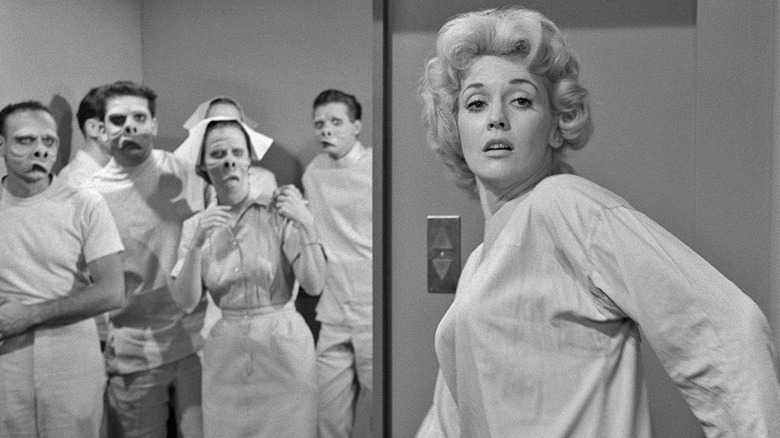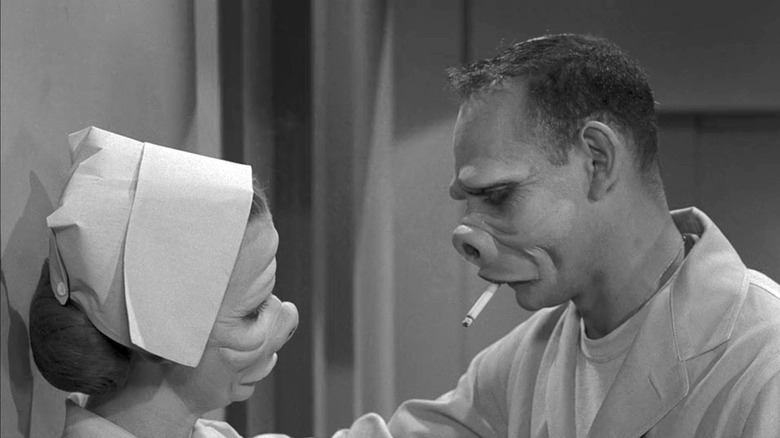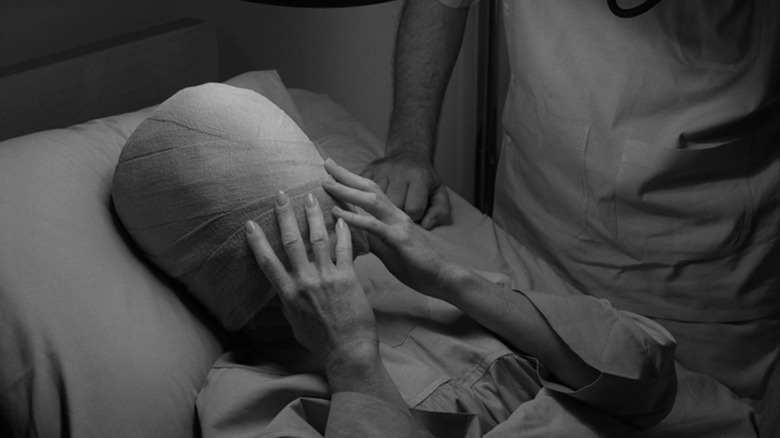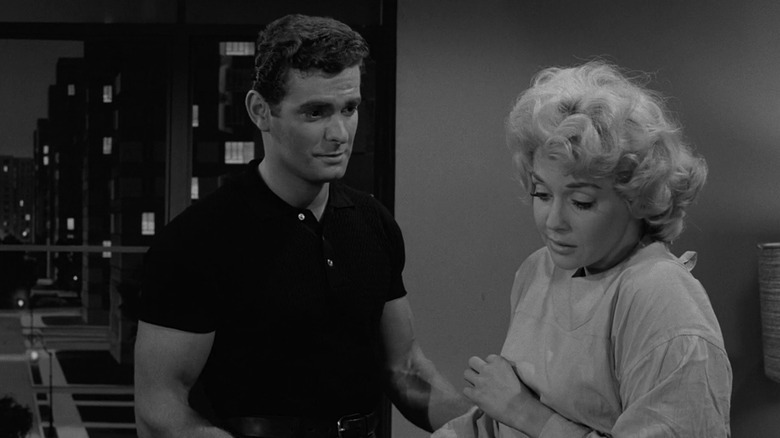How The Twilight Zone Pulled Off The Impossible For The Eye Of The Beholder
As beloved as "The Twilight Zone" is, it often gets made fun of for its occasionally shoddy twists. Sometimes the twist is so obvious everyone could see it coming from a mile away, and sometimes the twist feels random and arbitrary. There's a balancing act to making a plot twist both well-foreshadowed yet still surprising, and not all of the series' 156 episodes managed to pull it off.
Then there are the revered episodes like "Eye of the Beholder," which manages a twist that's obvious in hindsight, yet somehow still a total shock on first viewing. The episode follows a bunch of doctors who try to "fix" an ugly patient whose face is bandaged up for the whole first half. "Ever since I was a little girl, people have turned away when they looked at me," the masked woman, Janet, laments. "Funny, the very first thing I can remember is another little child screaming when she looked at me."
There's so much build-up to what we'll see when the bandages are taken off, so much emphasis on how ugly this woman supposedly is, it's easy not to notice that the camera isn't showing us any of the nurses' or doctors' faces. They certainly sound like normal, sympathetic people, so the assumption is that they are. It's only once Janet's bandages are taken off, revealing her as a beautiful woman by the audience's standards, that we get to see what the hospital staff look like.
"The idea was to make them look like pigs, with the big nostrils and piglike nose," said the show's make-up artist William Tuttle in "The Twilight Zone Companion," and he certainly succeeded. By our standards, these doctors and nurses are hideous, but those are not the standards Janet (Donna Douglas) is used to.
Casting based on voice, not appearance
For director Douglas Heyes, the casting of all the doctors and nurses was done without even looking at them: "I kept my back to them until after I'd heard them, because what I wanted from the doctors and the nurses were the most sympathetic voices that I could hear." He'd figured if the doctors had mean, unsympathetic voices, that would clue the audience in to the big twist too quickly. Making sure the actors sounded like what you'd expect beautiful people to sound like would further cement the assumption that the patient was the ugly one, not them.
As for Janet herself, Heyes cast two people: Maxine Stuart as Janet under the bandages, and Donna Douglas as Janet unmasked. He chose Stuart "because her voice did not suggest a beautiful girl — it suggested a strong, harsh, realistic woman, and therefore the unveiling would be a surprise." It was only Donna Douglas who was cast specifically for her looks: "She was not yet known to anybody, but she was absolutely beautiful," said Heyes. "So I said, 'You'll have a few lines, but later Maxine Stuart will dub them in her voice.'"
Although Heyes claimed that it was difficult to "find a great beauty who is that great an actress," he remarked that Douglas managed to be both. "When it came to the time that she was unveiled and she had these words to say, she did them so accurately in the same voice that we never dubbed her."
Not showing the doctors
Of course, the single most impressive part of the episode is the way it avoids showing us the Doctors' faces without calling much attention to what it's doing. All it would've taken was a single shot where the view of their faces was obviously obstructed, and the jig would've been up. It would've invoked the question, "wait, why aren't they showing us this?" and it only would've taken the average viewer a few extra seconds of thought to figure out why. On rewatch, the blocking of the hospital staff's faces is impossible not to notice, but it's done gracefully enough that the average first-time viewer wouldn't be clued in.
"I evolved a very complicated camera movement, by which you were seeing these doctors and nurses all the time but actually they would be passing one another at exactly the same moment that the camera would be, so that you wouldn't really see their faces," Heyes explained. "Or they'd go behind a pillar just as they were turning toward the camera and so on — and the place was shadowed."
The most important technique, however, was the way the episode focused on Janet's point of view. Even though we can't see her face throughout most of it, the camera sticks to her as she talks; the fact that the doctors' faces are obscured feels right because Janet herself can't see them. Why would we need to see their faces if Janet herself is perfectly comfortable not seeing them either? As Hayes put it, "We didn't know what they looked like, either, because she didn't."
Why it still works
To the savvier members of the audience, the twist might admittedly be a little obvious. After so much build-up to the woman being ugly, an ugly face reveal would surely be too straightforward. If you go in trying to guess the twist, you'd probably be able to predict that the woman won't be ugly at all, which would raise the obvious question of why the doctors keep saying she is, which would call attention to the fact that their faces are also hidden. If you're looking for an episode with a truly unguessable reveal, "Eye of the Beholder" isn't it.
Yet the episode holds up even on multiple rewatches because its meditations on the slippery, subjective nature of beauty are fascinating in their own right. Even before the twist, the story does a great job at getting you to emphasize with people who don't match the conventional standards of attractiveness, getting you to question the morality of the doctors who insist on looking for a "cure" for Janet's physical appearance.
The episode ends with Janet being banished from society to live with the other "ugly" people, but it's not fully an unhappy ending. The episode argues that a society as close-minded and shallow as this one is not worth living in, and it asks us to wonder if our own society is really so different. "The Eye of the Beholder" understood that a story still needs to be well thought-out and have a satisfying conclusion to truly count as an all-time great. The episode's big reveal scene might be the episode's claim to fame, but the episode's beauty goes much further down than that.



